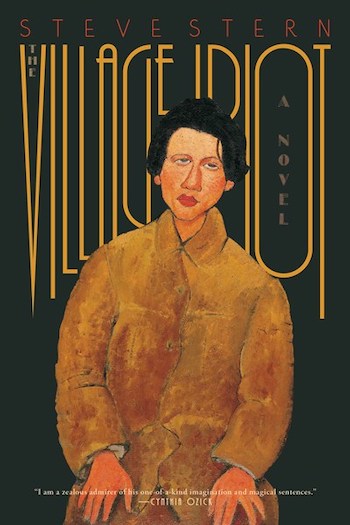In the protean landscape of contemporary fiction, the historical novel is among those having something of a moment. Given the literary world’s apparently endless quest for ever-marketable books placed within ever-tightening niches, this is on the whole not overly surprising. With access to real worlds that feel alien and actual characters lending themselves easily to dramatization, historical fiction nestles itself in a happy medium between accessibility and entertainment. This via media appears to be the (largely attained) endgame in and of itself for veteran writer Steve Stern’s latest novel, The Village Idiot.
The book is set in Paris during the first decades of the twentieth century—the backdrop for approximately one-third of all fiction. Opening along the Seine on a picturesque spring day, Stern wastes little time in plunging his reader into the riches of notable historical personage that his setting offers. The painter Amedeo Modigliani has, here in the springtime of The Great War’s penultimate year, set up a boat race among the Parisian artistic milieu. The sights and sounds of a Paris primtemps are on full display, painted in broad strokes by Stern’s gifted descriptions and turns of phrase. With a rare bottle of expensive wine to be awarded the winner, Modigliani has left nothing to chance, and it is in this way we first meet the Village Idiot himself. Beneath the brackish Seine, affixed by dubious contraption to his friend’s vessel, is Chaim Soutine, heaving his way through both book and stream.
Modigliani has asked much of Soutine—he is to drag the former’s boat across the finish line first while beset by the heft and draw of 1917’s latest in scuba gear—but not nearly as much as has Stern. As becomes apparent after the opening chapter, The Village Idiot is structured around Soutine’s life and career in Paris. Soon after moving to France, Soutine meets Modigliani and becomes entangled with many of this century’s most famous and notorious writers, painters, and thinkers. This little-known artist, moving in a renowned circle and channeling poignant themes, propels the book through années folles and Nazi occupation alike. Stern has won awards for his accomplishments as a Jewish writer, and the horrors of the Jewish experience during World War II, as personified and experienced by Soutine, are vividly rendered.
Such ambitious temporal movement does not prevent Stern from injecting much of his trademark humor into the book, however. Aided by his use of the present tense, The Village Idiot is often a playful, frolicking novel, one that leans well into the exuberance of Paris and the art world located at its heart. An early scene at a Montparnasse restaurant, where a neophyte Soutine starts a fire and is unable to even apologize in his nonexistent French, all while Modigliani looks on in unhelpful amusement, is illustrative:
Soutine and Modigliani had remained among the onlookers, standing under an arc lamp wreathed in smoke. They were joined there by the barkeep, whose disconsolate humor suggested he might also be the boîte’s proprietor. Having ceased his quiet sobbing, he turned toward them, his fat face terrible with its singed eyebrows and beard.
“Ja sooey dezolay,” said Chaim in his embryonic French. “I’m sorry.”
The brokenhearted man sniffled, then brought down a hammy fist upon the crown of the Litvak’s bare head. Chaim crumpled onto the cobbles from which Modi, himself unsteady on his pins, gently scooped him up.
This passage also captures the book’s distinctive voice which, for better or worse, carries its robust presence throughout. The effectiveness and palatability of the narrative style will vary from reader to reader, but the intent is clear. Even while The Village Idiot aptly wrestles with weighty issues such as the nature of art and the realities of the Holocaust there is, much like life itself, nonetheless much to enjoy and entertain.
While those slippery genre lines are forever blurred, it feels safe to locate The Village Idiot on a borderline between literary and historical fiction—that specific setting is consistently the book’s most successful element. While his style and rush to hit historical high notes can, even from the opening, border on what workshop peers call “information dumping,” Stern’s homework is meticulously done, and his strengths as a writer—sharp prose revealing deep confidence at the sentence level—help to illuminate his vibrant la ville lumière.
As strong as Stern’s research and his descriptive abilities are, however, he runs somewhat aground when navigating the dangerous waters of point-of-view. Perhaps the most notable, and certainly the least explicable, feature of The Village Idiot is the narration. Although the majority of the text reads like a fairly typical close third-person—allowing insights to characters’ hearts and minds, pasts and futures—it is in fact something of a frame job, encased in a transient, slippery I-as-witness who slips into the self-reflexive from time to time. The problem, for both book and reader, is this ghostly first person’s tendency towards over-explanation, his inability to remove himself, even for half a page, from a scene. While Stern’s language and wit are rightly praised, and give his novel a quick pace and lighthearted tone, many readers may nevertheless find themselves distanced by the ceaseless banter of our rather officious guide. Call it first or third, Stern’s narration suffers from what might be termed overknowledge, a suitably Orwellian description of The Village Idiot’s offbeat and off-putting control of information:
“I’m Apollo when I work,” [Modigliani] declared, uncorking a small vial of ether that he poured into his wine, “Dionysus when I’m away from my chisels and paints,” quaffing the glass and offering the dregs to his companion, who declined.
“Begging your pardon,” submitted Chaim, amazed at his own presumption, “but it’s a difference between to live and to work?”
Modi ignored him, rattling on about the sanctified enterprise of his art: that it was closer to le vrai, the real, than the world itself as it appeared to the unawakened soul…Coughing fruitily, he turned to gaze toward a window that overlooked the Hill of Martyrs, named for a decapitated saint whose severed head continued to preach. At the foot of the hill the lamplit city was spread out like a drunken spider’s web.
This excerpt captures the touch-too-much reliance on wit and snark as well as the tendency towards telling over showing; relating the gist of conversations rather than revealing them onscreen. This latter tic is a byproduct of that first-person frame; typically a narrating character is involved in the scenes they recount, and so the narrative focus feels natural even when pulled away from the immediate scene. But here the effect is an alienating one, stymieing an otherwise compelling moment between two vibrant characters. The Village Idiot, for all its achievements in story, setting, and character, is a fine if unintended example of the universal importance of narration and point of view in fiction.
But this flaw is not a fatal one, and in the final analysis, The Village Idiot is a well-researched passion project by an accomplished and clearly talented writer. The decision-making may leave more than a few readers puzzled but, for most, Stern’s latest effort will prove to be an enjoyable, earnest novel that wears its passions on its sleeve. For the reader wishing to be whisked away to an illuminated Paris in the twenties and beyond, The Village Idiot will surely stay afloat.

FICTION
by Steve Stern
Melville House Publishing
Published on September 13, 2022

